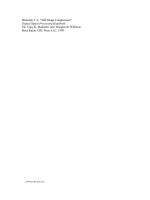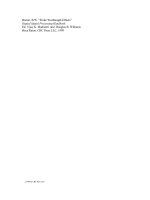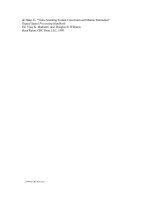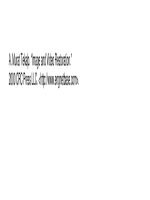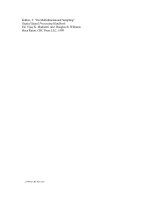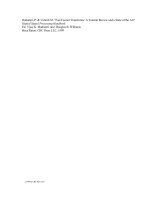Digital Signal Processing Handbook P57
Bạn đang xem bản rút gọn của tài liệu. Xem và tải ngay bản đầy đủ của tài liệu tại đây (298.8 KB, 12 trang )
Reginald L. Lagendijk, et. Al. “Stereoscopic Image Processing.”
2000 CRC Press LLC. <>.
StereoscopicImageProcessing
1
ReginaldL.Lagendijk
DelftUniversityofTechnology
RuggeroE.H.Franich
AEATechnology,
CulhamLaboratory
EmileA.Hendriks
DelftUniversityofTechnology
57.1Introduction
57.2AcquisitionandDisplayofStereoscopicImages
57.3DisparityEstimation
57.4CompressionofStereoscopicImages
57.5IntermediateViewpointInterpolation
References
57.1 Introduction
Staticimagesanddynamicimagesequencesaretheprojectionoftime-varyingthree-dimensional
realworldscenesontoatwo-dimensionalplane.Asaresultofthisplanarprojection,depthin-
formationofobjectsinthesceneisgenerallylost.Onlybycuessuchasshadow,relativesizeand
sharpness,interposition,perspectivefactors,andobjectmotion,canweformanimpressionofthe
depthorganizationoftherealworldscene.
Inawidevarietyofimageprocessingapplications,explicitdepthinformationisrequiredinad-
ditiontothescene’sgrayvalueinformation(representingintensities,color,densities,etc.)[2,4,7].
Examplesofsuchapplicationsarefoundin3-Dvision(robotvision,photogrammetry,remotesensing
systems);inmedicalimaging(computertomography,magneticresonanceimaging,microsurgery);
inremotehandlingofobjects,forinstanceininaccessibleindustrialplantsorinspaceexploration;
andinvisualcommunicationsaimingatvirtualpresence(conferencing,education,virtualtraveland
shopping,virtualreality).Ineachofthesecases,depthinformationisessentialforaccurateimage
analysisorforenhancingtherealism.Inremotesensingtheterrain’selevationneedstobeaccurately
determinedformapproduction,inremotehandlinganoperatorneedstohavepreciseknowledgeof
thethree-dimensionalorganizationoftheareatoavoidcollisionsandmisplacements,andinvisual
communicationsthequalityandeaseofinformationexchangesignificantlybenefitsfromthehigh
degreeofrealismprovidedbysceneswithdepth.
Depthinrealworldscenescanbeexplicitlymeasuredbyanumberofrangesensingdevices
suchasbylaserrangesensors,structuredlight,orultrasound.Oftenitis,however,undesirableor
unnecessarytohaveseparatesystemsforacquiringtheintensityandthedepthinformationbecause
1
ThisworkwassupportedinpartbytheEuropeanUnionundertheRACE-IIprojectDISTIMAandtheACTSproject
PANORAMA.
c
1999byCRCPressLLC
of the relative low resolution of the range sensing devices and because of the question of how to fuse
information from different types of sensors.
An often used alternative to acquire depth information is to record the real world scene from
different perspective viewpoints. In this way, multiple images or (preferably time-synchronized)
image sequences are obtained that implicitly contain the scene’s depth information. In the case that
multiple views of a single scene are taken without any specific relation between the spatial positions
of the viewpoints, such recordings are called multiview images. Generally speaking, when recordings
are obtained from an increasing number of different viewpoints, the 3-D surfaces and/or interior
structures of the real world scene can be reconstructed more accurately. The terms stereoscopic image
and stereoscopic image sequence are reserved for the special case that two perspective viewpoints are
recorded or computed such that they can be viewed by a human observer to produce the effect
of natural depth perception (see Fig. 57.1). Therefore, the two views are required to be recorded
under specific constraints such as the cameras’ separation, convergence angle, and alignment [8].
Stereoscopic images are not truly 3-D images since they merely contain information about the 2-D
projected real world surfaces plus the depth information at the perspective viewpoints. They are,
therefore, sometimes called 2.5-D images.
FIGURE 57.1: Illustration of system for stereoscopic image (sequence) recording, processing, trans-
mission, and display.
In the broadest meaning of the word, a digital stereoscopic system contains the following compo-
nents: stereoscopic camera setup, depth analysis of the digitized and recorded views, compression,
transmission or storage, decompression, preprocessing prior to display, and, finally, the stereoscopic
displaysystem. The emphasis here is on the image processingcomponentsof this stereoscopic system;
that is, depth analysis, compression, and preprocessing prior to the stereoscopic display. Nonetheless,
we first briefly review the perceptual basis for stereoscopic systems and techniques for stereoscopic
recording and display in Section 57.2. The issue of depth or disparity analysis of stereoscopic images
is discussed in Section 57.3, followed by the application of compression techniques to stereoscopic
images in Section 57.4. Finally, Section 57.5 considers the issue of stereoscopic image interpolation
as a preprocessing step required for multiviewpoint stereoscopic display systems.
57.2 Acquisition and Display of Stereoscopic Images
The human perception of depth is brought about by the hardly understood brain process of fusing
two planar images obtained from slightly different perspective viewpoints. Due to the different
viewpoint of each eye, a small horizontal shift exists, called disparity, between corresponding image
points in the left and right view images on the retinas. In stereoscopic vision, the objects to which the
eyes are focused and accommodated have zero disparity, while objects to the front and to the back
have negative and positive disparity, respectively, as is illustrated in Figure 57.2. The differences in
c
1999 by CRC Press LLC
disparity are interpreted by the brain as differences in depth Z.
FIGURE 57.2: Stereoscopic vision, resulting in different disparities depending on depth.
In order to be able to perceive depth using recorded images, a stereoscopic camera is required
which consists of two cameras that capture two different, horizontally shifted perspective viewpoints.
This results in a shift (or disparity) of objects in the recorded scene between the left and the right
view depending on their depth. In most cases, the interaxial separation or baseline B between the
two lenses of the stereoscopic camera is in the same order as the eye distance E (6 to 8 cm). In a
simple camera model, the optical axes are assumed to be parallel. The depth Z and disparity d are
then related as follows:
d = λ
B
λ − Z
,
(57.1)
where λ is the focal length of the cameras. Fig. 57.3(a) illustrates this relation for a camera with
B = 0.1 m and λ = 0.05 m. A more complicated camera model takes into account the convergence
of the camera axes with angle β. The resulting relation between depth and disparity, which is a much
more elaborate expression in this case, is illustrated in Fig. 57.3(b) for the same camera parameters
and β = 1
◦
. It shows that, in this case, the disparity is not only dependent on the depth Z of an
object, but also on the horizontal object position X. Furthermore, a converging camera configuration
also leads to small vertical disparity components, which are, however, often ignored in subsequent
processing of the stereoscopic data. Figures. 57.4(a) and (b) show as an example a pair of stereoscopic
images encountered in video communications.
When recording stereoscopic image sequences, the camera setup should be such that, when dis-
playing the stereoscopic images, the resulting shifts between corresponding points in the left and
right view images on the display screen allow for comfortable viewing. If the observer is at a distance
Z
s
from the screen, then the observed depth Z
obs
and displayed disparity d are related as:
Z
obs
= Z
s
E
E − d
.
(57.2)
In the case that the camera position and focusing are changing dynamically, as is the case, for
instance, in stereoscopic television production where the stereoscopic camera may be zooming, the
camera geometry is controlled by a set of production rules. If the recorded images are to be used for
multiviewpoint stereoscopic display, a larger interaxial lens separation needs to be used, sometimes
even up to 1 m. In any case, the camera setup should be geometrically calibrated such that the
two cameras capture the same part of the real world scene. Furthermore, the two cameras and A/D
converters need to be electronically calibrated to avoid unbalances in gray value of corresponding
points in the left and right view image.
c
1999 by CRC Press LLC
FIGURE 57.3: (a) Disparity as a function of depth for a sample parallel camera configuration;
(b) disparity for a sample converging camera configuration.
The stereoscopic image pair should be presented such that each perspective viewpoint is seen
only by one of the eyes. Most practical state-of-the-art systems require viewers to wear special
viewing glasses [6]. In a time-parallel display system, the left and right view images are presented
simultaneously to the viewer. The views are separated by passive viewing glasses such as red-green
viewing glasses requiring the left and right view to be displayed in red and green, respectively, or
polarized viewing glasses requiring different polarization of the two views. In a time-sequential
stereoscopic display, the left and right view images are multiplexed in time and displayed at a double
field rate, for instance 100 or 120 Hz. The views are separated by means of the active synchronized
shuttered glasses that open and close the left and right eyeglasses depending on the viewpoint being
shown. Alternatively, lenticular display screens can be used to create spatial interference patterns
such that the left and right view images are projected directly into the viewer’s eyes. This avoids the
need of wearing viewing glasses.
57.3 Disparity Estimation
The key difference between planar and stereoscopic images and image sequences is that the latter
implicitly contains depth information in the form of disparity between the left and right view images.
Not only is the presence of disparity information essential to the ability of humans to perceive depth,
disparity can also be exploited for automated depth segmentation of real world scenes, and for
compression and interpolation of stereoscopic images or image sequences [1].
c
1999 by CRC Press LLC
